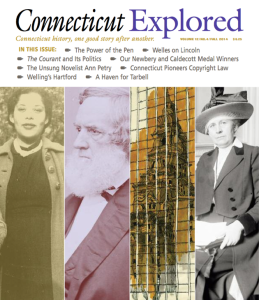By Walter W. Woodward
(c) Connecticut Explored Inc. Fall 2014 Volume 12 Number 4
Subscribe/Buy the Issue!
 Rarely is the pen more powerful than when it expresses a majority opinion of the United States Supreme Court. Sometimes eloquent, sometimes tediously legalistic, the decisions of the justices often turn words into history, even as they shape our futures. In surprising and unforeseen ways, perhaps no Supreme Court decision holds greater implications for future generations than the one issued in a case that began in New Haven a half century ago.
Rarely is the pen more powerful than when it expresses a majority opinion of the United States Supreme Court. Sometimes eloquent, sometimes tediously legalistic, the decisions of the justices often turn words into history, even as they shape our futures. In surprising and unforeseen ways, perhaps no Supreme Court decision holds greater implications for future generations than the one issued in a case that began in New Haven a half century ago.
In 1961, after six years as executive director of the Planned Parenthood League of Connecticut, Estelle Griswold teamed up with Yale School of Medicine physician Dr. C. Lee Buxton to challenge the 1879 Connecticut statute criminalizing the sale and use of contraceptives, whether “drug, medicinal articles, or instrument.” They opened a small public birth control clinic in downtown New Haven on November 1 of that year. Nine days later, both were arrested, and later convicted, of providing contraceptives to a married couple. With the aid of pioneering civil liberties lawyer Catherine Roraback, Griswold’s case worked its way through Connecticut’s appeals court system until it reached the United States Supreme Court in early 1965. The high court’s decision that Connecticut had violated a citizen’s fundamental right to privacy not only established the right of Americans to use contraceptives, it also paved the way to the 1973 Roe v. Wade ruling that stated laws banning abortion were unconstitutional.
While Griswold will continue to provide a landmark precedent in cases involving reproductive rights, it is likely to play an equally significant role in a looming legal storm over an issue that wasn’t even dreamed of in 1961—what rights American citizens have to protect the privacy of their digital information. In its majority decision on the Griswold case, the court found that even though the Bill of Rights never explicitly uses the term “privacy,” that document implicitly established a general constitutional right to privacy. Justice William Douglas wrote in the majority decision that Griswold “concerns a relationship lying within the zone of privacy created by several fundamental constitutional guarantees.” This new concept of a constitutionally protected “zone of privacy” was created in particular response to the issues raised by Estelle Griswold’s case, but the justices knew it had broader implications.
What couldn’t be known is how rapidly and dramatically the invention of the personal computer (the Altair 8800) in 1975 would also affect privacy. Today the meaning of our right to a “zone of privacy” is being tested in completely new ways by a world in which our most personal financial, medical, and even social information resides in digital cloudbanks, accessed by people we never see for uses we may not even recognize or know about. The revelations of Edward Snowden, the Target data breach, the Heartbleed virus, not to mention Facebook, Twitter, Pinterest, Tumblr, LinkedIn, Instagram, and flickr, all raise essential questions about what part of our personal information is, or should, remain exclusively ours. A long series of court challenges in the years ahead will, no doubt, come to establish the new parameters of the American right to privacy. In every one of those cases the three words “zone of privacy”—penned in the decision that resulted from Estelle Griswold’s act of civil disobedience in New Haven in 1961—will mark the starting point of the discussion.
Explore!
“Women Who Changed the World,” Summer 2011
“Connecticut Women Fight for Reproductive Rights,” Fall 2017
Read all of our stories about Health & Medicine on our TOPICS page
Read all of our stories about Notable Connecticans on our TOPIC page
Read more stories from Fall 2014: The Power of the Pen
